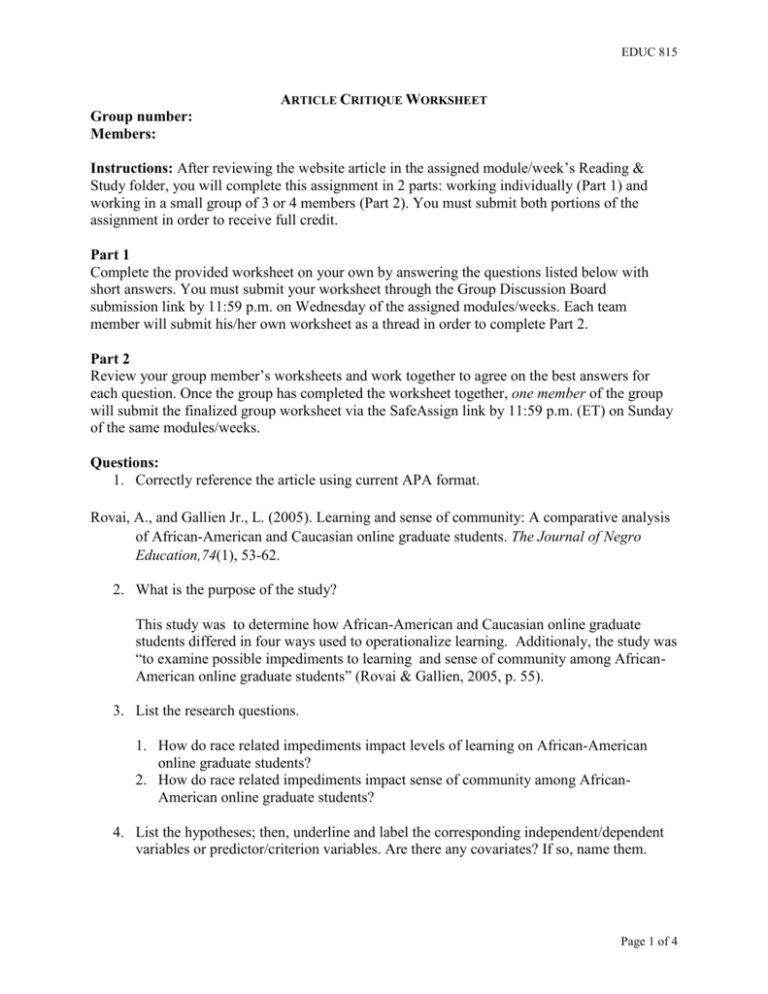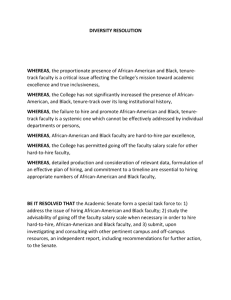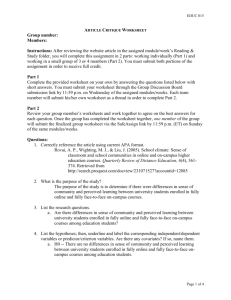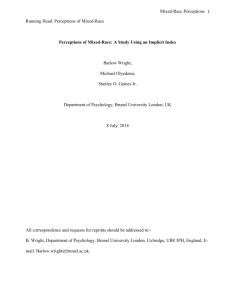EDUC 815 Article Critique Worksheet Group number: Members
advertisement

EDUC 815 ARTICLE CRITIQUE WORKSHEET Group number: Members: Instructions: After reviewing the website article in the assigned module/week’s Reading & Study folder, you will complete this assignment in 2 parts: working individually (Part 1) and working in a small group of 3 or 4 members (Part 2). You must submit both portions of the assignment in order to receive full credit. Part 1 Complete the provided worksheet on your own by answering the questions listed below with short answers. You must submit your worksheet through the Group Discussion Board submission link by 11:59 p.m. on Wednesday of the assigned modules/weeks. Each team member will submit his/her own worksheet as a thread in order to complete Part 2. Part 2 Review your group member’s worksheets and work together to agree on the best answers for each question. Once the group has completed the worksheet together, one member of the group will submit the finalized group worksheet via the SafeAssign link by 11:59 p.m. (ET) on Sunday of the same modules/weeks. Questions: 1. Correctly reference the article using current APA format. Rovai, A., and Gallien Jr., L. (2005). Learning and sense of community: A comparative analysis of African-American and Caucasian online graduate students. The Journal of Negro Education,74(1), 53-62. 2. What is the purpose of the study? This study was to determine how African-American and Caucasian online graduate students differed in four ways used to operationalize learning. Additionaly, the study was “to examine possible impediments to learning and sense of community among AfricanAmerican online graduate students” (Rovai & Gallien, 2005, p. 55). 3. List the research questions. 1. How do race related impediments impact levels of learning on African-American online graduate students? 2. How do race related impediments impact sense of community among AfricanAmerican online graduate students? 4. List the hypotheses; then, underline and label the corresponding independent/dependent variables or predictor/criterion variables. Are there any covariates? If so, name them. Page 1 of 4 EDUC 815 H01 – The African-American-only students in the African-American-only section of the course would not achieve higher levels of learning than the African-American students in the mixed-race section. H02 – The African-American-only students in the African-American-only section of the course would not achieve stronger sense of community than the African-American students in the mixed-race section. H1 – The African-American-only students in the African-American-only section of the course would achieve higher levels of learning than the African-American students in the mixed-race section. H2 – The African-American-only students in the African-American-only section of the course would achieve a stronger sense of community than the African-American students in the mixed-race section. Variables – Levels of Learing (DV), Sense of Community (DV), Total Course Points (DV), Section of course – Mixed or non-mixed (IV) 5. Do the questions pose an ethical or moral problem for implementation? Why or why not? The questions could, but likely do not, pose an ethical or moral problem for implementation. Online graduate students, as a class, tend to be more mature. In that all participants were employed in the field of education, these participants were aware of the study and presumably advised of its nature before participation. 6. Do the questions or hypotheses measure any theoretical constructs? If so, list them. The hypothesis implies a theoretical construct that there is a difference in levels of learning and sense of community between African-American online graduate students enrolled in African-American only courses and course mixed with Caucasian students. 7. Do the author(s) clearly identify the participants and setting? If so, describe them. The study clearly identified the participants and setting as follows: Participants: Participants for this study consisted of 97 students enrolled in an online graduate education program. The volunteer rate was 97.40%. Males (n = 11) represented 11.34% of participants while females (n=86) represented 88.66% of the participants. African-American students (n=50) represented 51.55% of the participants while Causasian students (n=47) represented 48.45% of the students. The mean age of the participants was 42.51 (SD = 7.90). (Rovai & Gallien, 2005) Setting: Page 2 of 4 EDUC 815 An online graduate course in educational research was taught by the same male Caucasian professor in two sections. One section (n = 20) was exclusive to African-American students and the other (n = 77) consisted of both African-American and Caucasian students; this section was subdivided to ensure no section had more than 30 students. Students were to learn skills to plan, conduct, and critique education research as well as to develop a sophisticated understanding of quantitative and qualitative research and an appreciation for the study of social phenomenon. Students in the mixed-race section were strictly internet and from variend geographic locations. Students from the African-American only section were co-located in an urban area and were presented the material in a hybrid fashion, meeting on-an-a-half days per month on a face-to-face basis. 8. What research design is used and why? “A causal-comparative research design was used to respond to the following research question: Does a combination of total course points, perceive learning, social community, and learning community in a graduate ALN education course differ based on student race” (Rovai & Gallien, 2005, p. 57). An analysis of the mixed-race and the single-race sections of the course was compiled. Also, and analysis of the students of the single-race section was compared with the AfricanAmerican students in the mixed-race section and with the Caucasion students in the mixed-race section. 9. What type of sampling method is used? The present study used a convenience sample of online graduate education students offered during multiple sections of one online and hybrid educational research course. 10. What are the names of each instrument used in the study (provide a list)? Perceived Learning Questionnaire (PLQ) Classroom Community Scale (CCS) Student self-reporting 11. Are the instruments valid and reliable? Why or why not? Validity: Validity of the CCS was confirmed by Rovai (2002). Validity of the PLQ was confirmed by McCrosky, Sallien, Fayer, Richmond, & Barraclough, 1996). Reliability: Reliability of the CCS was confirmed by Rovai (2002). Reliability of the PLQ was confirmed by McCrosky, Sallien, Fayer, Richmond, & Barraclough, 1996). Page 3 of 4 EDUC 815 12. Do the author(s) give enough detail regarding the procedure so that the study could be replicated? How or how not? Sufficient detail regarding the procedure was given so that the study could be replicated. The PLQ and CCS were given to the students via online surveys during the last three weeks of the term. 13. What type of statistical analysis is used and why? A causal-comparative research design was analyzed using Multivariate Analysis of Variance (MANOVAs) for each analysis using grouping as the independent variable. 14. What are the major conclusions of the study? How do they relate to the hypothesis? Data here indicated that in the case of perceived learning and total points score, there were no statistically signicant differences between the single-race group and the mixedrace group. However, in the case of classroom community, the single-race section scored higher by a statistically significant margin. In that H1 indicated higher levels of learning in the single-race group, that hypothesis is rejected. However, H2 indicated higher sense of community among the single-race group, in that instance, the related null hypothesis is rejected. 15. Do the author(s) suggest any future studies to resolve ambiguities in the present study or to answer questions raised by the present study? In the future, researchers may want to tailor the study to provide a more equivalent gender base. Also, the hybrid method of the one course could be credited as much with the higher sense of community among the single-race section as the identification of that section as a single-race section. A study comparing sense of community among hybrid students as compared to online students would by viable. “Additional research is indicated using different samples and university settings” (Rovai & Gallien, 2005, p. 61). Page 4 of 4







